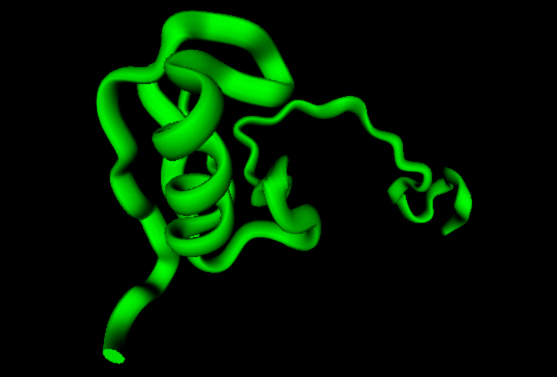Artist Gene | Code | Genetic Code | Cloning | Transformation | Protein | WEB Interface |Back to Eduardo Kac: Genesis
Genesis Protein

Artist Gene | Code | Genetic Code | Cloning | Transformation | Protein | WEB Interface |Back to Eduardo Kac: Genesis

Genesis protein, Eduardo Kac, 2001.
Shown above is the three-dimensional structure of the Genesis protein, the first art protein.
Protein visualization
was carried out with the assistance of Charles Kazilek and Laura Eggink, BioImaging
Laboratory, Arizona State University, Tempe.

Transcription
Jewels, Eduardo Kac, 2001. Glass, purified Genesis DNA, gold, wood
"Transcription
Jewels" is a set of two objects encased in a custom-made round wooden
box. The word "transcription" is the term employed in Biology to
name the process during which the genetic information is "transcribed"
from DNA into RNA. One "jewel" is a 2" genie bottle in clear
glass with gold ornaments and 65 mg of purified "Genesis" DNA inside.
"Purified DNA" means that countless copies of the DNA have been
isolated from the bacteria in which they were produced and accumulated and
filtrated in a vial. The gene is seen here out of the context of the body,
its meaning intentionally reduced to a formal entity to reveal that without
acknowledgment of the vital roles played by organism and environment, the
"priceless" gene can become "worthless". The other "jewel"
is an equally small gold cast of the three-dimensional structure of the "Genesis"
protein. By displaying the emblematic elements of the biotech revolution (the
gene and the protein) as coveted valuables, "Transcription Jewels"
makes an ironic commentary on the process of commodification of the most minute
aspects of life. Both the purified gene in "Transcription Jewels"
and its protein are not derived from a natural organism, but rather were created
specifically for the artwork "Genesis". Instead of a "genie"
inside the bottle one finds the new panacea, the gene. No wishes of immortality,
beauty, or intelligence are granted by the inert and isolated gene sealed
inside the miniature bottle. As a result, the irony gains a critical and humorous
twist by the fact that the "precious commodity" is devoid of any
real, practical application in biology.
Transcription Jewels was produced with the assistance of Dan Collins, Scott Bingham, Charles Kazilek, David Lorig, and James Stewart, with partial support from the Institute for Studies in the Arts, Arizona State University, and Langlois Foundation, Montreal.
Source: http://www.ekac.org